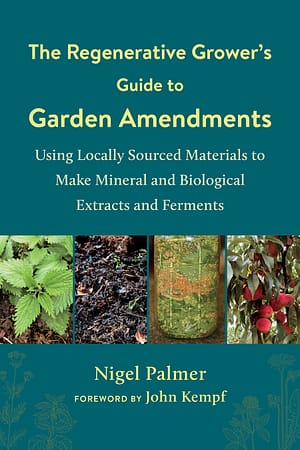Testing Soil: Healthy Soil is Just A Test Away

Testing soil in your garden is the first step to a more bountiful harvest. It’s not as hard as you might imagine, either — simply take a small sample, get it examined, and you’ll be on your way to healthy soil and a promising harvest this season.
The following is an excerpt from The Regenerative Grower’s Guide to Garden Amendments by Nigel Palmer. It has been adapted for the web.
Testing Soil: The Fundamentals
An important first step is to identify a testing lab that will conduct a test that includes all the microminerals and trace minerals of interest. Soil tests need not be conducted every year, making this a reasonable investment, especially if no information about the mineral content of the soil is available.
In order to evaluate soil mineral content, the lab staff rinses samples in a weak acid solution. The acid solution simulates the weak acids that the soil biology produces in order to break down minerals (rock particles). This test is a way to estimate the availability of minerals in the soil.
Soil Testing Methods

More recently a testing method called a Haney soil test has become popular. Discussing these test methods with a specific lab will shed light on which may be best for a particular situation.
A lab should offer detailed directions on how to conduct a soil test and the nature of its analysis. Look for this information on the testing lab’s website.
Once you’ve chosen a lab, it’s a good idea to keep using it over time to limit any sources of test variation when comparing results year after year.
Testing Soil: When To Test
Another way to reduce variation is to collect soil samples for testing at the same time every year. It is interesting to note that soil mineral proportions change over the course of a year, and that the fall represents a low point in soil mineral content.
This is a lovely concept to ponder, because it brings to light the power of soil biology over those cold winter months and early spring working to digest available minerals for next year’s plants to ingest. Yes, the soil digestive system continues working even in the depths of winter.
Conducting a soil test in the fall captures this low point of the mineral availability cycle, and it’s a time of year when other garden chores may have subsided.
Collecting A Soil Sample For Testing
In general, collect samples from the top 6 inches (15 cm) of the soil, which is (theoretically) equivalent to the depth of the root zone of many crops. This 6-inch depth is also relevant when doing calculations of amendment needs. There is a special device one can buy that collects perfect “cores” of soil.
Another easy way to collect a sample is to use a trowel.
Before digging, be sure the tools used for gathering, mixing, and packaging are clean and not contaminated by rust or other contaminants.
Scrape away any plant or other debris from the surface of the soil and dig the hole a little over 6 inches deep. Remove a sample about 2 inches (5 cm) thick from the side of the hole, slicing down about 6 inches. Be sure that the sample does not include any material other than soil.
Gather several samples in this manner from various spots in the garden. As a rule of thumb, collect five or six samples within a 50-by-50-foot (15 × 15 m) area. The goal is to determine the average characteristics of the garden’s soil overall.
Next, thoroughly mix all the individual samples together in a clean bucket. Once mixing is completed, remove 1 to 2 cups of soil from this bucket.
This represents an average of the top 6 inches of soil in the garden. Package this up and send it to the lab for analysis. And remember, even more detailed instructions for collecting samples should be available through the testing lab.
Testing Soil: The Results
The first time the soil is tested, the results may be disheartening, but fear not.
Even in a new garden that has some soil imbalances, the harvest of freshly picked produce will still be more nutritionally rich and flavorful than store-bought produce that was picked long ago and transported hundreds or thousands of miles.
Also keep in mind that it may take longer than one year to correct many soil mineral deficiencies. It may take several years.
The same may be true for excesses—it may take several years before those levels decline to an optimal range. The important thing is that objective information is now available to develop both long- and short-term amendment strategies. Just imagine how good those tomatoes will taste next year!
Recommended Reads
Recent Articles
Oxeye daisies are one of the most important plants for pollinators including beetles, ants, and moths that use oxeye daisies as a source of pollen and nectar. Instead of thinking about removing a plant like oxeye daisy, consider how you can improve the fertility and diversity of habitat resources in your home landscape, garden, or…
Read MoreSo you want to start reaping your harvest, but you’re not sure where to start? Learn how to break down the options of harvesting tools!
Read MoreWhat’s so great about oyster mushrooms? First, you can add them to the list of foods that can be grown indoors! They are tasty, easy to grow, multiply fast, and they love a variety of substrates, making oyster mushrooms the premium choice. The following is an excerpt from Fresh Food from Small Spaces by R. J.…
Read MoreEver heard the phrase, “always follow your nose?” As it turns out, this is a good rule of thumb when it comes to chicken manure. Composting chicken manure in deep litter helps build better chicken health, reduce labor, and retain most of the nutrients for your garden. The following is an excerpt from The Small-Scale Poultry…
Read More








